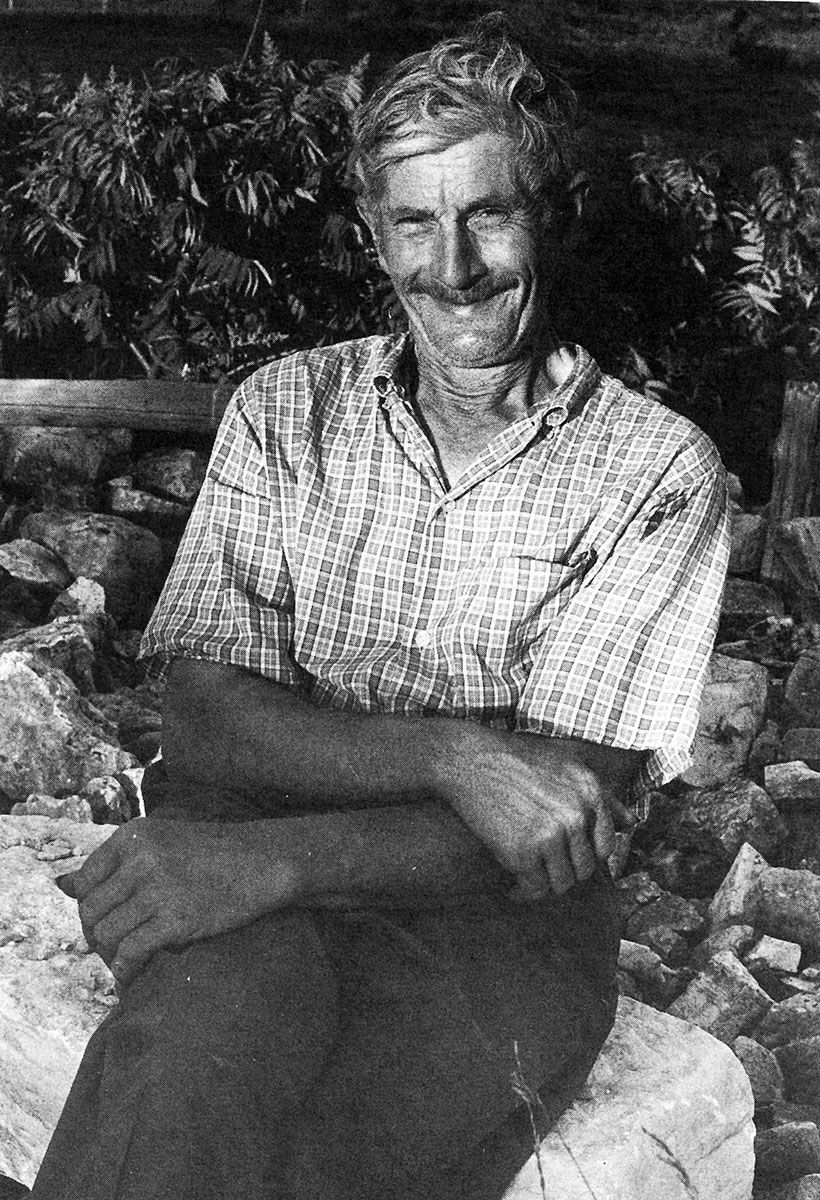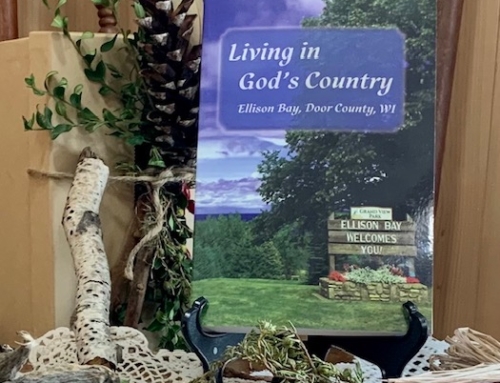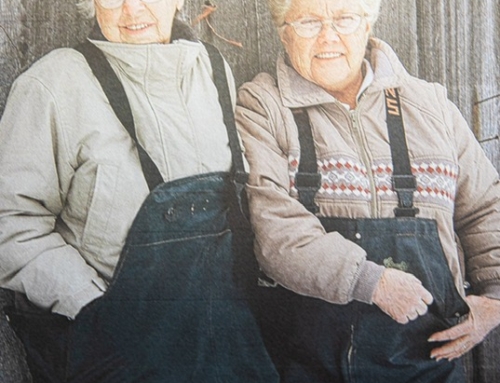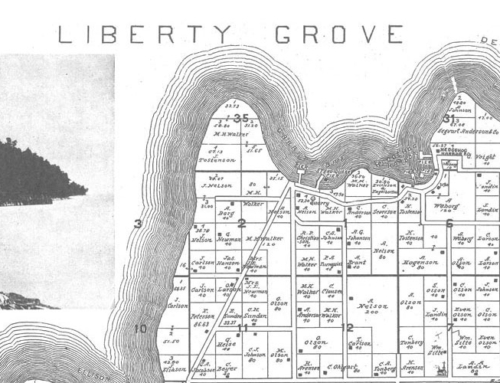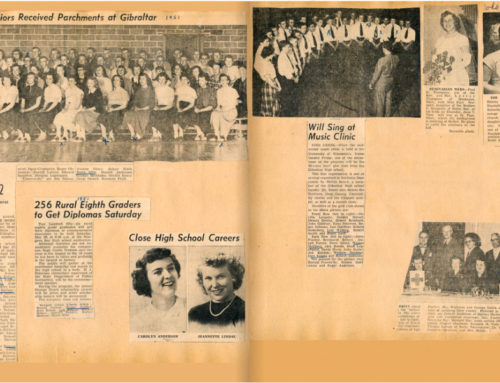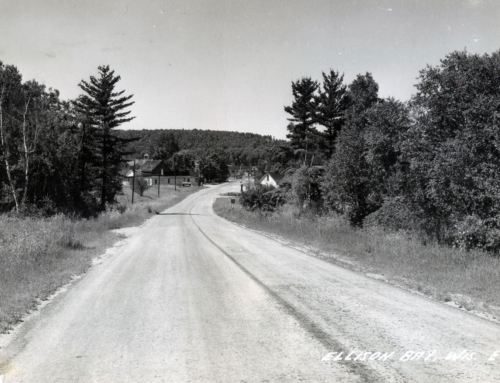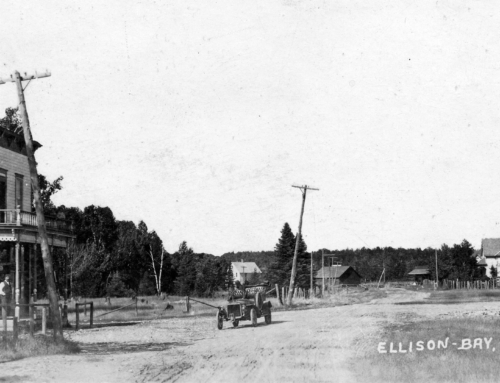By Lauren Mitterman
From Door County Almanac #4 (1st printing June 1987)
Fred Kodanko is the keeper of a precious harvest; one hundred years of stories about farming. He holds the memories of his grandparents and parents, the tales he has heard of life on Door County farms from the turn of the century.
Fred Kodanko makes his living today as a farmer, the third generation of his family to work the Door County soil. He lives on a small parcel of land that was once part of the 120-acre homestead his Austrian immigrant grandparents settled 100 years ago. His grandparents knew this land when it was rich with timber. They cleared the forests of maple and pine by hand, pulling the stumps from the land with teams of oxen, bending countless times to pick by hand a mountain of stones, leaving only rich brown earth. Decades of their perseverance together with the toil of their children and grandchildren turned the acres into productive farm fields and pastures.
I met Fred, now 74 years old, at the home of his youngest sister, Joanne (Mrs. Harry Wehling). The Wehling home is also located on land from the original Kodanko tract along Townline Road in Liberty Grove. I spent several hours studying the family photo album with Joanne and Fred, sitting back to listen while oldest brother and youngest sister shared their stories of the days they spent as farm children on the Door County peninsula.
Joanne handed Fred a photo of their father. The kitchen was silent as Fred studied the picture of a whiskered man with a lean face and dark eyes. “My father, John Kodanko, came to America from Austria with his parents, Carl and Walburga, in the year 1882,” said Fred, leaning forward in his chair and concentrating as if to remember every detail of the story his father had handed down to him. “Dad was one year old, and he had an older brother, Rudolph, who was four years old. They all left Austria in August and didn’t get to New York until the later part of September – six weeks to cross the ocean! The trip usually only took one month, but they had as high as four or five days of calm. They only took provisions along for a month and here they were, two weeks over their schedule. They were right down to starving I guess! They came to America on a three-masted schooner…five families from Austria, all got together and came to this part of the country. They were told in Europe that there was such wonderful timber here in the United States.”
Fred gestured towards the 100-year-old barn next to his home across the road. “Where we are now is all part of the land they homesteaded here in 1888. The original homestead was 120 acres – this road (Townline Drive) goes through eight acres of it.”
The first task that faced the new immigrants was clearing their land. “They had to cut timber first before they could even open up enough land to raise something to eat. They started with oxen…they trained up steers to do their farming. That was slow work, clearing the new land with all the stumps and stones. They were like mules, those oxen! I remember my father telling the story of when he was ten years old. One morning he was out here, helping to hitch up the oxen…setting yokes on the steer’s necks and putting on the chains. The doggone oxen got loose and kicked my dad right in the face. Yes, they worked hard just to clear the timber and get something to eat!”
Eight more children were born after the family settled in America; Annie, Bertha, Matilda, Minnie, Mary, Charlotte, Frank and Charles. The children helped to milk the cows and to plant the ever-increasing cleared lands. In the cold winter months, after the timber on their own farm had been cleared, the older sons went to work at logging camps in Michigan.
“When he was just 17 years old, my father joined the loggers in Michigan, about 1904. From six in the morning until six at night for 1 dollar a day. Can you imagine? Making railroad ties. Cutting down those big pine trees, 3-4 feet thick in the stumps and then get them down to the river. His younger brother, Frank, was up there too. Boy, people don’t work like that nowadays!”
“Only time they had off was Sunday, and you know what they did on Sunday? They washed their clothes and sharpened their tools! My dad was the head filer…those guys could really make headway!”
“My father was an expert at filing saws and an expert at the violin. He got himself a violin when he went up to the Michigan woods – ordered it from Sears Roebuck. He had it with him in the camp, and every chance he had he’d go and play. After he came back to Door County, he used to play for house parties. He’s have the whole floor of people dancing just with the violin and stamping his foot. A one-man band!”
“My father was 30 years old when he married my mother, Ethel Starrine…she was 21. They lived just down the road from each other. (She lived on the next farm where Don Spearo lives now). She and dad borrowed a horse and buggy and went to the parsonage in Baileys Harbor to be married, July 24, 1912. The first years they were married my father worked on the family farm, and also worked around as a hired hand for different farmers. Those days there was a guy named Ole Thompson, and my dad said he worked for him for 50 cents a day. The newlyweds lived with my grandmother Kodanko in the white house right down the road from here. That was the third home built on the homestead…put up around 1910, I think. They lived there when I was born and my sister Katherine.”
Fred smiled and his eyes twinkled as he told the story of his birth. “I was the oldest in the family, born on the 5th of March, 1913. I was born in the blizzard of 1913, worst blizzard ever was in this county! There were a lot of ships that went down in the lake during that winter, hauling lumber and pulp wood. The storm was so severe my father and his brothers couldn’t even get the horse out of the barn, let alone get a midwife. They only had to go 200 feet from the house to the barn, but they couldn’t make it! Had to hang onto each other and go back against the storm so they wouldn’t get lost. If they separated one or the other would have gotten lost in the blizzard.” Fear turned to joy for the young family when Ethel safely delivered her first-born son.
John and Ethel Kodanko continued to work the family farm and to save money toward the purchase of their own land.
Fred’s sister, Katherine, was born in 1915, and the following year the family was able to buy 80n acres in Peninsula State Park next to Middle Road. “When we first got there the only buildings were a barn and a house and an old two-story logging cabin,” said Fred. “We used the logging cabin to store grain and later for a woodshed.”
“And a playhouse”, Joanne added, “the second story of the cabin was the placed we played on rainy days.”
Fred was 3 ½ years old when the family moved to the Middle Road Farm. “The earliest I can remember I guess is riding with my mother and father to church (St. Mary of the Lake Catholic Church) in Baileys Harbor. Nine miles from the park to the church, one way. Before we had the horse and buggy my parents said we walked sometimes! I can remember going to mass with my little straw hat with a ribbon on it, knee pants and button shoes.” Fred laughed at the memory. “I was all dressed up for church, must have been about four years old.”
“Another time when I was four or five, I can remember Dad and me going to have our flour made in Baileys Harbor at Prueter’s Flour Mill. Going to church would only take us about an hour and a half, but with the wagons loaded heavy the trip to the mill took almost 2 ½ hours. The flour mill was four stories high, and the basement was used for the saw mill and lumber kiln…all powered by steam. It was something for a little fellow to see and hear, four stories of machinery all going at one time. Roller mills, the wheat crushed by rollers and then it went on to the sieves, the fresh flour went one place and the millings come around another place, the bran another place. I guess I was too little to watch it all at once! I remember we got there about eleven o’clock and we didn’t get done with our wheat until 2 p.m., then got home close to five I guess.”
Fred told story after story about his mishaps with horses as a young boy. “You know,” he laughed, “I never did like horses! Dad got me to lead the big 1600 pound horse when I was seven years old. I didn’t have the strength to lead him on the sides, my arms were pulling straight up into the air! Dad was hollering at me to lead them more, and I just didn’t have the strength. ‘I’ll fix him’ thought my dad, and he put me up on the horses and had me to check the lines, you know. I tried to hang on to the mane and to steer at the same time. I started bellowing and bawling ‘Get me off of here’ and that’s the last time I was on a horse!”
“Dick and Lady…that was the team Dad used to clear the land and pull the wagon. He had to go up to Reynolds Bros. in Sturgeon Bay to buy them…they were a young team 5 or 6 years old.”
“I almost had a serious misfortune with Dick when I was 12 years old. If I had been one second slower, I wouldn’t be here today. I would have been pinned behind a horse in the barn. Someone was driving a new station wagon down the road, and I wanted to see it. (I guess it was about 1925). I ran behind that horse and never expected him to lift his hind foot. That foot rattled my jacket buttons, but out the door I was! That’s how close I was to being pinned against the wall. Old Dick put a dent in the wall three inches deep with his hoof, in a cedar block wall! You could see that dent in the siding even on the outside. Yes, my jacket buttons were rattling!”
The young family worked to add buildings and crops to the farm, and Fred welcomed three more sisters to the growing family; Laura, Margaret and Marion. Fred shared the feelings he had when he was 12 and learned that yet another baby girl had been born. “We finished the big barn four months before Joanne was born. Here I was the only boy…and we already had four girls. Now there were five! But when I went to school (seventh grade) I hollered to the other kids, ‘Well, I had another sister this morning!’ “ Fred smiled at Joanne, and said with a softer voice, “You know, I remember her first cry.”
The large family meant many mouths to feed but also many hands to share the work. “We raised everything on that farm,” said Fred, “potatoes, corn, wheat, oats, hay, raspberries, a big vegetable garden.” My dad was a real truck gardener. He would deliver a lot of the produce to Camp Meenahga. (Then an exclusive girls’ camp located in Peninsula State Park.) We also had orders from the Ephraim and Fish Creek hotels and cottages, and all those Cottage Row people.
“We’d raise strawberries and raspberries…work all day to pick raspberries. We’d pick as high as one hundred quarts in a day. We had a fruit stand out by the road and we’d sell the berries there.
“As I got older, in the summer I’d work with the older children and my parents in the fields, making and shocking hay. The only ones left at home were the little ones like Marion and her (pointing to Joanne) just 12 and 8 years old, I guess. Sometimes we would have as high as thirteen cars filled with customers in the yard…we didn’t even know who got there first.”
“And we’d run and hide,” confessed Joanne, laughing, “we were so bashful.”
“The little ones would sure make themselves scarce when the customers came”, laughed Fred, “they didn’t want to tend to people.”
“I remember the blackberry bushes would grow right outside the porch,” Fred said. “My mother had flowers in the garden and in the yard – she loved them. Gladiolus and dahlias, tulips, all the cut flowers. Carl Anderson (a neighbor in the park area who had a small greenhouse) got her going with all kinds of different flowers. Phlox, goldenglow, lilacs, moss roses…and petunias. She used to have us kids get an old washtub and fill it up half full with ground, and then she’d plant moss rose in there. Pa would help us set it on a block of wood out in the yard. Yeah, all kinds of nice things were growing when we were kids.”
“Our early chores on the farm were to pick rocks, weed the garden, carry wood and water. We’d have to help feed the animals. You know,” laughed Fred, “the hay was upstairs and the cows were downstairs!”
“You’d have to climb a ladder through a hole about four foot square up in the barn and throw the hay down. The ladder went pretty much up to the peak of the barn when the hay was piled high. I was 10 or 11 years old I guess.”
“Milking the cows…I remember when the cows would step the bottom out of the milk pail. That was a heck of a mess. If they got their foot in and didn’t get stuck you could maybe restrain the milk. If the foot was clean it wasn’t too bad, otherwise you’d give it to the cats. Do you know how long it took me to milk one tough cow we had? One and a half hours! You know – the milk come out of that teat like just so you could barely see the stream. You’d squeeze as hard as you could, and there’s this stream come out like it was number twelve thread! We made beef out of her because she was so tough to milk and you know, that meat was tough too!”
“We had another cow, eighteen years old, that we fattened on corn. When we butchered her, we had tender meat like a yearling. If you fatten a cow on corn, the meat is really good.”
“During the winters I used to help my dad in the woods, even when it was 7 or 8 below zero, cutting wood. Boy, you’d get cold though. Mom was knitting socks day and night. She kept the whole family going with socks and nice heavy mittens.”
“I didn’t have to do too much in the winter months when there was school. We all went to the Fish Creek Grade School.”
Joanne and Fred smiled as they tried to remember the names of favorite teachers. “Helen Chancelor, Helen Anderson, and of course, Ray Slaby,” said Joanne. “We all had Ray Slaby as a teacher. We went to school from September till June, except if we were sick or snowed in…or if it was 12-15 below.”
Fred remembered “tramping trail” for his younger sisters through the snow. “We walked from our farm to school – 1 ½ miles to the highway, and then 1 ½ miles to school. I remember one time Katie and I saw a wolf sitting close by the trail on our way home from school. It was sitting about ten feet off. We had to sneak around through the brush and when we finally got back on the trail did we go! I bet you we made a quarter mile in ten minutes! Weren’t too many wild animals to worry about, few wildcats in the trees or a coyote.” “Or skunks”, laughed Joanne. “But I do remember walking home from school in the dark through the woods. We left home by 8 in the morning, and got to school by 9. Then school was out at 4 p.m. and we weren’t home until 5.”
Joanne told the story of the day the bears visited her parents’ farm. “They had a game farm down near our farm, and I remember the bears got out and were grazing in our field. Cows, deer and bear – all together!”
Fred remembered the State sent men out with box traps to capture the bear, “The game farm was down near Nicolet Bay, I guess they charged an admission for people to see the lynx, fox, rabbits…all kinds of stuff. But the one that fed them just forgot to close the gate one day. One bear got up on Carl Anderson’s greenhouse and fell right through the roof on top of all the flowers!”
“In the winters we used to fish herring down at Nicolet Bay there, through the ice. My dad and I used a line and some hooks…we didn’t need any bait, just put some buttons or red yarn on the line. The herring come around the hole in the ice there six feet around and five feet deep! One solid mass of herring looking for something to eat! We thought those herring were something to eat fried in fresh pork fat or pickled.”
Nearby Camp Meenahga was an important part of Kodanko family life, with the family delivering produce to the camp almost every day. The older girls worked at the camp dishwashing, helping the cooks or waiting on tables. The children often attended the Camp Meenahga play held outdoors in August, and the annual horse show.
The Kodanko family lived on the farm at Peninsula State Park for 29 years. The daughters grew up and married (Fred remains a bachelor.) In 1944, the State bought the land to become part of Peninsula State Park. The farmhouse, logging cabin, and barn are all gone now. “The only traces of the farm there now are the snowball bush and lilac bush,” said Joanne. “I even think the apple trees are gone now too.”
“Apple trees and lilac bushes,” said Fred quietly. “That’s where you can see the remains of many old homesteads in Door County…by the lilac bushes.”
Fred Kodanko closed the family album as if to press the memories tightly, safely between the pages to be kept for another day. We turned our conversation to his plans for this year’s crop; to raise potatoes for the Fish Boilers and other customers.
“I guess you could say I’m serious about Fish Boil potatoes,” Fred smiles. “I wanted to be a potato raiser for years, and the last two years have been my best! Danny Peterson (owner of the Viking Restaurant in Ellison Bay) was my best customer last year…7,100 pounds of potatoes and 300 pounds of onions. I remember he cooked 250 pounds of potatoes one Tuesday afternoon and evening – served 450 people that day! It keeps me busy keeping him supplied!”
Fred is also famous for the cedar crates he makes – a popular item with many visitors and local shop owners. “Years back I watched Ed Koessl make crates. He’d pick up scrap lumber and plane it down, saw it off with a handsaw, and make potato crates. After I seen what he could make, I could make them too! People started buying the boxes for shop displays and then their customers would ask where they could buy them! People find me from word of mouth, one person to another. Lots of people from Chicago, Minnesota, Delaware, even California! Once in awhile they asked me to autograph a box. I use mostly cedar, or some spruce, balsam or birch. I started making crates for the apples and potatoes the farmers and orchards raised. Now very few people buy them for fruits or vegetables. The college kids use them for bookshelves or satchels, I guess.”
Talking of crates reminds Fred of the work waiting for him at home. Younger sister, older brother rise to put away the family album. After we say goodbye to Fred, Joanne stops me to say that today was the first time she had heard the story of how her grandparents came to America. We both take a few more minutes to reflect on the wonderful harvest of stories and memories that many families never gather, and promise ourselves that we will take time to ask the questions and to listen…to reap the countless precious stories the older members of our family have to share. To store the stories like seeds to give to our children…




